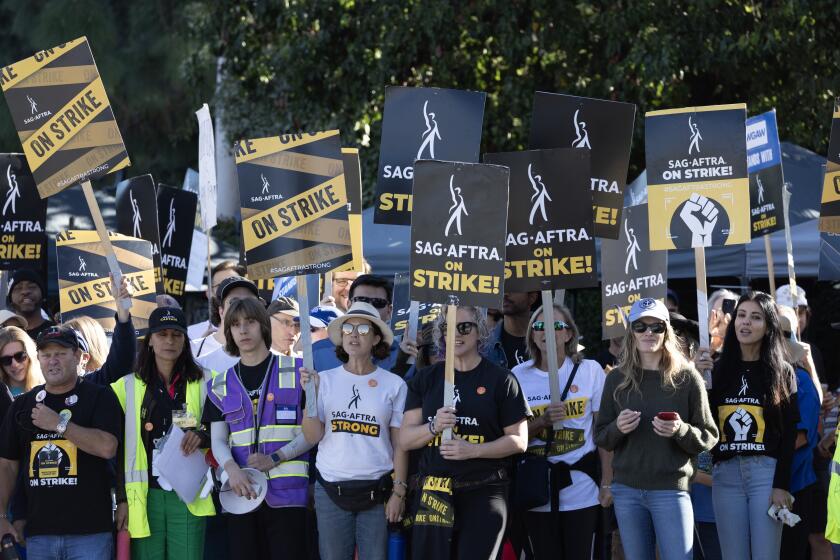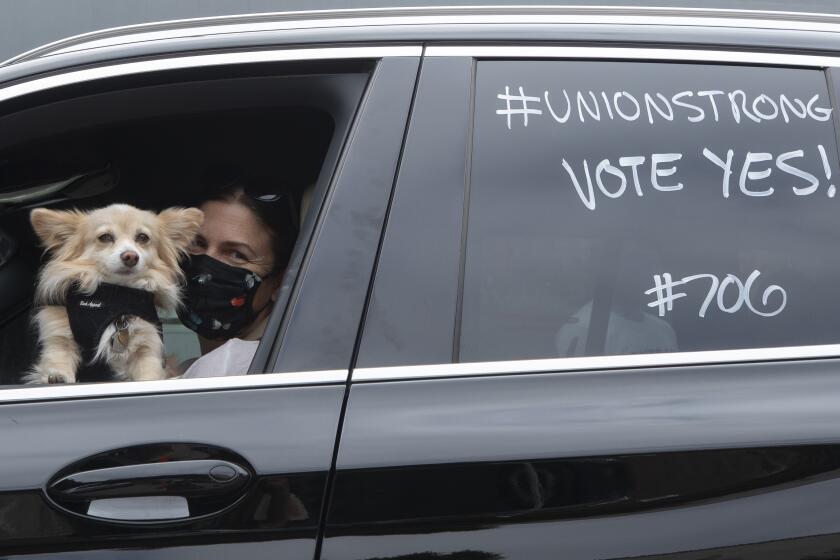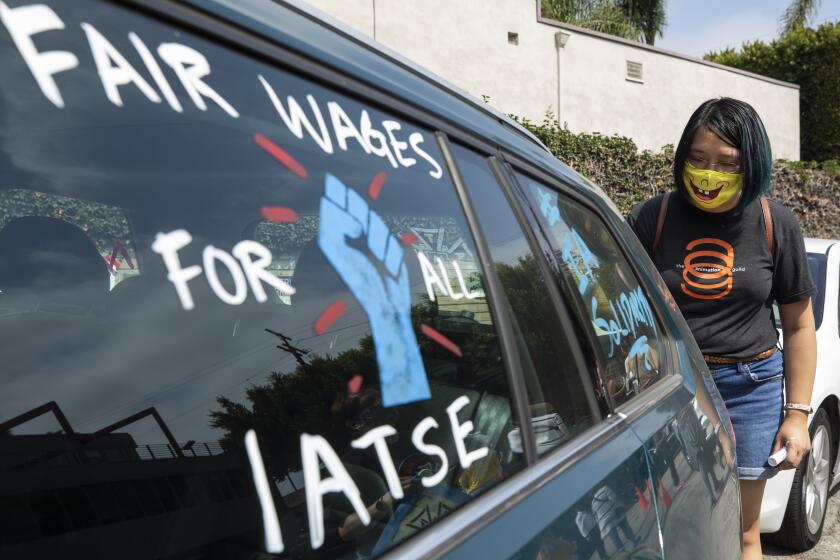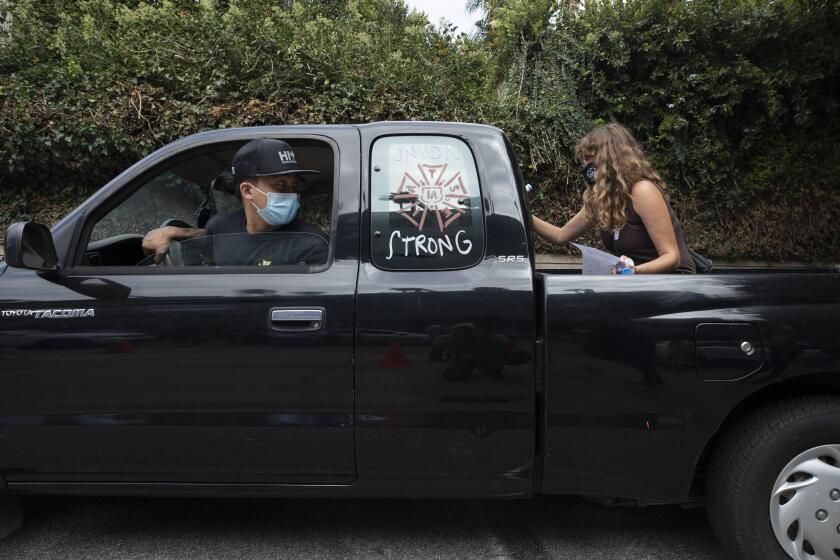Hollywood crew members take center stage as IATSE negotiations kick off

- Share via
Thousands of Hollywood crew members and their supporters gathered Sunday in the crisp morning air and muddy fields at Encino’s Woodley Park in a show of unity ahead of contract negotiations that begin this week with the major film and TV studios.
Slogans such as “Fighting for living wages,” and “Nothing moves without the crew” adorned dozens of tents representing everyone from cinematographers and costume designers to lighting technicians and video editors. Some demonstrators had just returned to work after last year’s strikes by writers and actors, while others hadn’t been employed since last summer.
“Every union in the entertainment industry is standing here together, and that has never happened before,” said Matthew Loeb, international president of the International Alliance of Theatrical Stage Employees, on Sunday. “We stand here together to demand fairness, to demand a living wage ... for everybody who works in this business.”

Sunday’s rally, organized by IATSE, Teamsters and other unions representing more than 66,000 Hollywood crew members, underscored that the labor unrest that roiled the entertainment industry last year is not over.
After writers and actors secured historic gains by striking for nearly six months combined, camera operators, makeup artists, costumers, carpenters, animal trainers and others who work behind the scenes on film and TV sets are pursuing demands for improved pay and working conditions as their contracts with the major entertainment companies come up for renewal.
Hollywood’s twin strikes translated into a lost year of production for much of the industry with productions idle since last spring. SAG-AFTRA’s strike against major media companies stretched 118 days.
IATSE, Teamsters Local 399 and the Hollywood Basic Crafts — a coalition of guilds representing drivers, electrical workers, cement masons, plumbers and other laborers employed on film and TV sets — are all scheduled to enter contract negotiations with the Alliance of Motion Picture and Television Producers on Monday. Their current contracts with the studios are set to expire July 31.
Union leaders are looking to ride a wave of labor activism that has fostered a rare degree of solidarity between organizations that have clashed in the past.
For the first time in 36 years, IATSE, Teamsters and the Hollywood Basic Crafts will jointly bargain for their pension and health benefits, while negotiating the rest of their terms separately.
The Otis College of Art and Design recorded a 17% employment drop in the entertainment industry in Los Angeles during the Hollywood strikes.
“The difficulties in our industry in the last few years — from the work stoppages last year to the pandemic work stoppages of 2020 — we came together in a way to weather those difficult times,” said Vanessa Holtgrewe, assistant department director of motion picture and TV production at IATSE.
“What’s different about going into our negotiations is that we’ve already established these relationships in a much more impactful and meaningful way in terms of labor solidarity,” added Teamsters Local 399 leader Lindsay Dougherty. “It’s our time.”

The so-called below-the-line unions are seeking wage increases that will keep up with inflation and update overtime provisions for crew members, who tend to work long hours. Wage scales for crew members are as varied as their crafts, ranging from less than $30 per hour to hundreds of thousands of dollars per year, depending on the job title and the type of production.
The guild also intends to place guardrails around the use of artificial intelligence, which could threaten the jobs of artists who typically work with performers at risk of being replaced by digital doubles (similar to how Teamsters animal trainers have been hampered by computer-generated imagery).
The unions also are seeking enhanced retirement and healthcare packages for crew members, whose jobs can be “incredibly physical,” Holtgrewe said.
Crew members are expressing frustration at the length of the writers’ and actors’ strikes as Hollywood workers struggle to pay for rent, food and healthcare.
Nonetheless, the unions face significant challenges as many producers and workers alike are ready to move on from last year’s unrest, which led to a near-total production shutdown and a 17% decrease in employment across the local entertainment industry, according to a study released in December by the Otis College of Art and Design with Westwood Economics and Planning Associates.
The overlapping strikes dried up crew members’ jobs, drained their savings and drowned them in debt. Many struggled to pay for housing, food and other essential costs.
“They’re barely starting to breathe, the workers, from the economic hardships of the previous two strikes,” said Sanjay Sharma, a professor at USC Marshall School of Business. “So that’s [the unions’] weak point.”
At the same time, Sharma added, it’s in the companies’ best interests to prevent another work stoppage, which the unions can use to their advantage.
Workers in film and TV, most of whom are pro-union, have been trying to make ends meet amid a dual strike of Hollywood actors and writers.
A third consecutive strike is a scenario that both sides undoubtedly are hoping to elude. The studios are hurting too, after the writers’ and actors’ strikes disrupted their production slates and hastened a long-brewing industry contraction that has manifested in mass layoffs at Warner Bros. Discovery, Amazon MGM Studios, Prime Video, Pixar, Paramount and other entertainment giants.
“As we enter negotiations, the AMPTP is committed to engaging in an open and productive two-way dialogue with our union partners that focuses on keeping crew members on the job without interruption, recognizes the contributions they make to motion pictures and television, and reinforces a lasting collaboration that ensures the industry and those who work in it thrive for years to come,” a spokesperson for the alliance said in a statement.
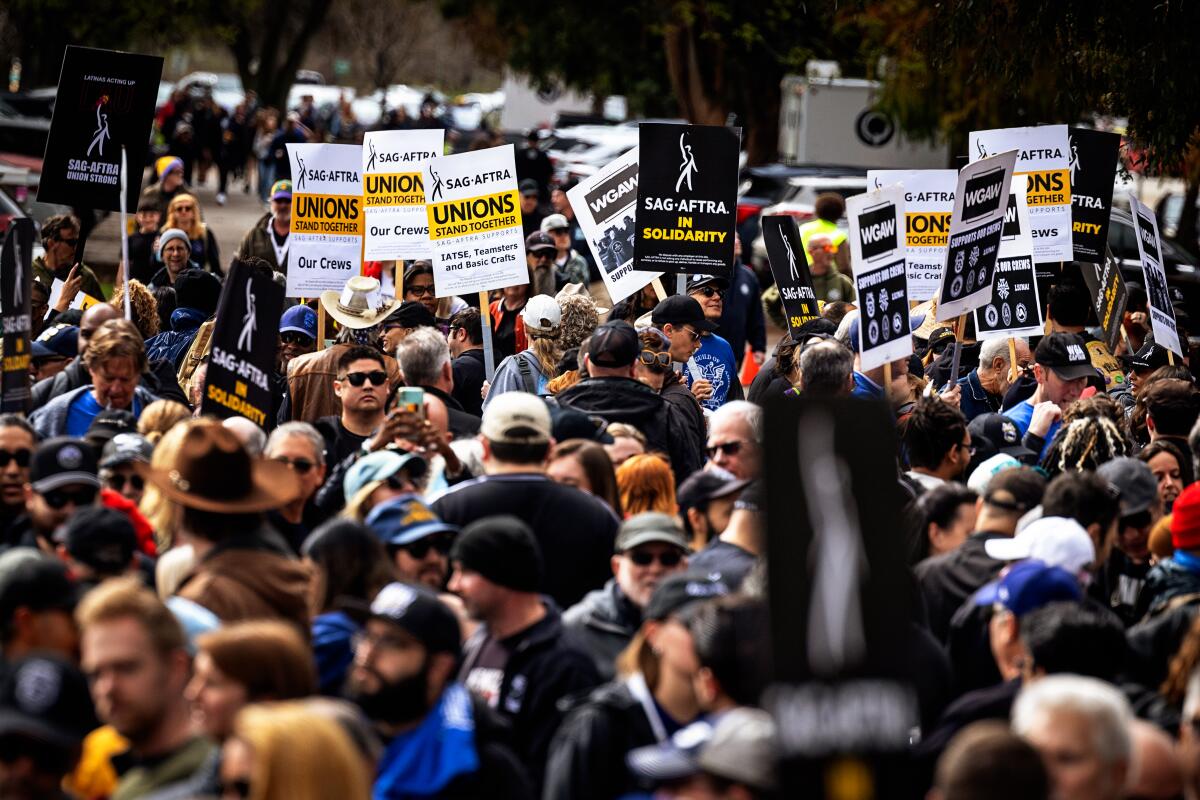
Historically, IATSE, the largest crew member union, has avoided labor showdowns with producers in order to keep members employed; it is known for being less aggressive than the Writers Guild of America and the Screen Actors Guild-American Federation of Television and Radio Artists. IATSE has not been on a national film and TV strike in its 130-year history.
But rank-and-file members have grown increasingly restive in recent years, voting overwhelmingly in favor of authorizing a strike in October 2021. (A walkout was averted when members narrowly approved a deal that included a 3% annual wage increase and a 10-hour minimum break between shooting days.)
The union has indicated that it is prepared to hold another strike authorization vote in the event that a resolution is not reached by the end of July. On the other hand, the preceding walkouts hit crews particularly hard, leading some to wonder if IATSE members will be willing to go without work again so soon.
“A lot of us are more broke than we’ve ever been, more angry, more frustrated,” said script coordinator Nicole “Colby” Bachiller, an IATSE member. “However, we do know how strong our union can be when all of its members are united.”
Members of the International Alliance of Theatrical Stage Employees authorized their leaders to call a strike if they can’t work out a deal with the major studios.
Even when they’re consistently employed, film set workers described working marathon days that add up to 60-plus-hour weeks for meager pay.
Bachiller said she is expected to be on call “24/7” and hasn’t been paid above the minimum for her job classification since she launched her entertainment career in 2014. She makes $26 per hour.

“The stuff that we’re asking, it’s not ... too much,” said Bachiller, who has worked as a production assistant and script coordinator on the CW’s “The Vampire Diaries” and ABC’s “The Rookie.” “It’s literally the bare minimum.”
Earlier this month, the International Alliance of Theatrical Stage Employees voted in support of waging a strike if the union couldn’t agree to a new contract.
The crew members’ unions are expected to seek similar wage increases to those secured by the WGA and SAG-AFTRA, whose members received initial pay bumps of 5% and 7%, respectively. (Background actors, stand-ins and photo doubles got a separate 11% boost in compensation.)
Although IATSE has not disclosed its demands, discourse around safety and healthcare for crew members has ramped up following high-profile incidents on film and TV sets. Recent examples include the fatal shooting of “Rust” cinematographer Halyna Hutchins in New Mexico and the death of lighting technician J.C. “Spike” Osorio, who fell while working on the upcoming Marvel TV series “Wonder Man” in Studio City.
“I’ve put my life into this,” said Doug Weaver, a driver and transportation captain who has worked on projects such as Paramount’s “Top Gun: Maverick” and Apple’s “Killers of the Flower Moon.” “You want to know ... that your healthcare is gonna be there for you.
“I’m on the downhill of my career,” he added, “so pension and being taken care of as I get older is a big, big factor for me.”
IATSE reaches a deal on a new contract with the Hollywood studios, which would end a months-long standoff that threatened to trigger a historic strike.
Consistent with the writers’ and actors’ campaigns, IATSE is pushing for protections around the use of artificial intelligence in filmmaking.
The new SAG-AFTRA contract states that performers must be compensated for days they would have worked in person to film scenes that instead feature AI-generated digital replicas. But what about IATSE members in the costume, makeup and hairstyling departments who are hired to dress and primp those performers on set?
“When I worked on ‘Space Jam 2,’ they scanned all of the background [actors],” said costumer and costume designer Edward Luís García, whose credits also include FX’s “American Crime Story” and Apple’s “Lessons in Chemistry.” “That directly takes jobs out of costumers’ hands.”
IATSE members have narrowly approved a new three-year deal with Hollywood studios in a vote that highlights divisions in the union.
A study released in January by the Animation Guild found that sound editors, rerecording mixers, broadcast technicians, audio technicians and video technicians were among those most at risk of having their jobs disrupted by AI in the next three years. All of those crew members are represented by IATSE.
“Artificial intelligence can be a powerful tool, but we won’t let it become a weapon that displaces our members,” Holtgrewe said.
Meanwhile, Teamsters Local 399 has expressed concerns about the rise of autonomous vehicles and how that technology could affect the safety and job security of drivers on film and TV sets.
“There’s no way autonomous vehicles could ever do what a trained driver, Teamster, could do,” Weaver said. “Any kind of technology that starts infringing on our ability to do our job and affecting people’s livelihoods would be something that would be very, very difficult to swallow.”
More to Read
Inside the business of entertainment
The Wide Shot brings you news, analysis and insights on everything from streaming wars to production — and what it all means for the future.
You may occasionally receive promotional content from the Los Angeles Times.

